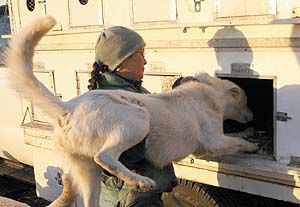| Musher Linda Clarke, of Buena Vista, Colo., loads one of the ‘pups’ into the dog truck after she, her husband and their dog handler, feed and water the animals. While handling the dogs is almost always joyful, it is not always the cleanest of jobs. With 23 more canine athletes in tow, the trio will be heading north to Montana for more training and, then in mid-February, continue on to Alaska to race in the Iditarod. |
The athletes go by the names of Marbles, Freddie, Geyser, Ollie, Brisco, Froggie, Rodney and Honda. The Alaskan huskies and, along with 16 canine partners, are traveling to compete at one of the premier sporting events on the North American continent – the Iditarod dog sled race.
Last Wednesday night and Thursday morning, the team and the dogs’ owners, Lachlan and Linda Clarke, visited Wellington.
But the stop over was not planned.
“We broke a fuel line on the way from Green River last night,” said Lachlan, who hails from Buena Vista, Colo.
He is a musher who has run the well-known race three times and will be going for his fourth competition in March.
“We pulled in here and they told us they could fix it, but they couldn’t get the part in until today,” continued the musher.
The Clarkes and dog handler Stephen Winterroth spent the night in a Wellington motel. The canines slept in the animals’ quarters on the dog truck.
Early Thursday morning, the mushers were up and had the dogs out on chain lines while they fed and watered the animals.
“This is what we do during the winter,” said Linda, who doesn’t run the Iditarod, but takes 12 to 14 dog teams through less famous races in Colorado, Idaho and Montana each year. “We are going to Montana first to do some training and then we are going to come down to a race in Idaho. Then we will head to Alaska for the big race.”
Running a dog sledding team takes commitment, time and money. Mushers must be physically fit. They also have to worry about equipment being maintained and make certain that dogs are trained as well as properly cared for all year long.
Lachlan became interested in mushing when he took a dog sled ride in 2001 in Steamboat Springs, Colo. From there, he and Linda became so hooked to the sport that, within a year, he had qualified for the Iditarod and the couple were running a team in the long race.
During the summer, the Clarkes run horses on a ranch and Lachlan participates in polocrosse, a sport in which he is considered one of the top players in America.
In the wintertime, the team trains in the mountains of Colorado and follows a course toward various races.
Dog sledding is as varied as car racing. Autos have NASCAR, drag racing, dirt track racing, IROC, etc.
Dog sledders may opt to participate in a wide variety of races.
The types of dogs, equipment and training are adapted to accommodate the kinds of races.
Some dog sled races are a few miles long.
In other longer dog sled racing events, the teams compete for an extended period of days on set courses and times are kept.
The team managing to complete the competition with the lowest overall time wins the race.
The Iditarod is classified by many sports fans as the Super Bowl of dog mushing and the Clarkes have sponsors for the couple’s team.
The costs of transportation, veterinary care for the animals, feeding the dogs and general living expenses along the way to Alaska are tremendous.
The purse for the 2007 event is estimated at $794,800 and all finishers get money.
More than 100 teams will participate and about 50 percent to 60 percent are expected to finish the race.
In the race, 12 to 16 dogs may be used during the 1,150 mile course.
“On this truck, we have about eight leader dogs,” said Linda as she hugged one of the crew. “We use them in different ways on the trail and in various conditions.”
Some dogs are better leaders on winding trails, while others are better on the straight sections.
Some canine athletes perform extremely well in snowstorms and foggy weather conditions, while other dogs are top-notch when it comes to running across frozen bodies of water.
Since the Iditarod began in 1973, times for running the course have dropped considerably.
In 1973 Doug Wilmarth won the competition in 20 days, 49 minutes and 41 seconds.
Last year, Jeff King took the race in nine days, 11 hours, 11 minutes and 36 seconds.
Martin Buser set the race’s record time in 2002 when his team finished in eight days, 22 hours, 46 minutes and two seconds.
Last year Team Clarke came in 63rd place with a time of 13 days, 20 hours, 26 minutes and 41 seconds.
On Friday morning, the Clarkes left Carbon County and headed north across Soldier Summit to Interstate 15.

